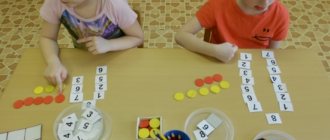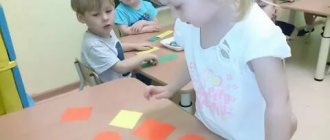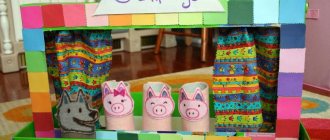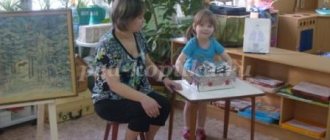Joint activities with children: 5 interesting options
Quite often, parents believe that their joint activities with their child will not bring the desired effect. After all, in order to raise a comprehensively developed personality, we need specialists who master the most modern techniques.
In addition, mothers often refer to lack of time: “When should I draw with my child? I barely have time to feed him, check his lessons and go grocery shopping... Why waste precious free minutes on this?”
Of course, developmental circles are useful for any child, but they do not exclude or replace joint activities with loved ones. After all, it is at home that children can try in practice what they were taught in the courses. In addition, only at home can a child develop the most important social skills - the ability to listen, conduct dialogue, show participation, care for others and express his feelings. Without parental support, a child simply cannot learn all this.
1 Family Collection
Especially recommended for overly emotional and anxious children.
Gathering is a very rewarding activity. It gives us a feeling of stability. Have you noticed that often, after experiencing emotional excitement, kids shake out all their toys and, sorting through them, gradually calm down? Or do they carefully arrange cars and dolls in a certain way before going to bed? This ritual has a calming effect on them. Having grown up, children refuse stuffed hares, and just at this moment parents can invite them to collect something together.
If you already have a ready-made collection, invite your child to add to it. You can combine this process with the study of history, physics or something else. The topic depends on the subject of the collection. But whatever it is, such an activity is a great way to bring children and parents together. You can start now!
2 Go study
Especially recommended for: insecure primary schoolchildren and teenagers.
There are situations that seem to be specially created to praise children. That is, tell them how talented they are (smart, resourceful, etc.) immediately at the moment of success. You can, for example, study languages together. Or go to a dance with your daughter, and take a computer graphics course with your son.
In a co-education situation, the child feels “on an equal footing” with his parents. He gets the opportunity to show that he is better than adults in some ways, and truly shines before our eyes. Don't hesitate to ask him for help if you can't understand a rule or learn a difficult move. For children - both toddlers and teenagers - such moments add self-confidence. The child also gains the most important experience of support. The opportunity to encourage your mother (“don’t worry, you will succeed!”) and help her achieve what she wants is priceless. And it greatly strengthens self-confidence.
3 We can do it!
Especially recommended for: children who are not responsible enough.
The opportunity to help mother with housework creates a child’s sense of self-worth and, most importantly, teaches him to bear responsibility. The main condition of the process is to do everything together. The directive scheme “I bake a cake, and then you wash the dishes” is not suitable. After such instructions, any housework becomes a boring chore. The task of adults is to turn it into a joint game, and then the child will perceive even washing the floors as an adventure. Among other things, this is also a great way to relieve all family members from the feeling of “household routine”.
Do not miss
- Do not miss
Fun with kids: 11 ways to make slime from shampoo (you'll love it too)
4 Expressing feelings
Especially recommended for: introverted children who have difficulty expressing their feelings.
Parents of an introverted child sometimes have no idea what worries, upsets, or, conversely, makes him happy. He constantly holds back his emotions. Over time, secrecy becomes almost the main character trait, and then it becomes almost impossible to force a person to be frank. Free creativity will help teach your child to express and share emotions. It provides a huge toolkit that allows you to talk about your joys, sorrows and fears without words (introverts have plenty of them). The adult’s task is to show the child all the ways that are acceptable for working with feelings. Clubs are more focused on the technical side of the process, and parents can help their child “have a blast.”
5 Don't rush anywhere
Especially recommended for: children experiencing lack of attention.
Lying on the couch, playing with a kitten, thinking “what should I do?” - it’s so meaningless, aimless and... very useful. For a child, moments of relaxed “doing nothing” with their parents become one of the most pleasant and warm memories. The secret is that we can only laze around from the bottom of our hearts with truly dear people. The lazy activity of “nonsense” sometimes turns out to be the most bonding thing: adults do not make comments to the child, do not read notations, do not remember the “C in algebra,” but simply enjoy life with him. The time when we are together and not in a hurry is the most valuable time for a family!
Top 5 board games
Board games are perhaps the most accessible form of family entertainment. This is a useful, fun and exciting activity. Moreover, there are many games that are equally interesting to kids, teenagers, and mom and dad.
✓ “Monopoly” from 5 years, minimum 3 players. This classic economic strategy with fun twists has been at the top of the list of the world's most popular board games for many years. Gambling, witty and extremely useful (learning to count money) entertainment for all family members.
✓ “Nonsense” from 3 years old, minimum 2 players. This game develops speech, imagination and... a sense of humor! “Nonsense” does not require any costs: take a notebook and pencils and invite all participants to take turns writing words, so that the result is a funny story. Crazy stories are welcome!
✓ “Ropes and Dragons” from 6 years old, minimum 3 players. An educational and witty strategic thinking trainer. You throw the dice, make a move on the playing field and receive a certain task (they are written on the cards). Until you cope, you won’t go further. The winner is the one who reaches the finishing point first.
✓ “Danettes” from 5 years old, minimum 3 players. The presenter takes a card from the deck and reads aloud the story written on it (the explanation is written on the back and the presenter knows it). The participants' task is to get to the bottom of the story by asking questions that can only be answered with “yes” or “no.” The one who names the correct answer first becomes the new leader.
✓ “Bazinga” from 12 years old, minimum 4 players. Two teams with an even number of players compete against each other. Using special cards and a tape measure, a word is selected (there are different levels of difficulty), which must be drawn, shown in pantomime, or described without using the same root words.
Text: Svetlana Ievleva
Games with parents to strengthen parent-child relationships.
Games with parents to strengthen parent-child relationships.
Game "Tender Name".
Remember how affectionately they call you at home. We will throw the ball
each other. Whoever gets the ball says a few of their names. Parents call them what their parents called them in childhood.
Game "Name".
Each participant says his name and characterizes himself with the first letter. Zhenya is cheerful, Marina is a good girl.
Game "No Rules".
Goal: creating an atmosphere of acceptance and understanding, developing communication skills, active listening.
Parent and child sit next to each other. It is important that the parent and child, using the expression: “I
think that you don’t love..., and I think that you don’t love..”,
open up to each other “as it is” - with those feelings for which there is neither a reasonable explanation nor judgment - this is how I see, this is how I feel.
Game "No Rules".
Parent and child using the expression: “ I love it when you
..." It is important to give a positive aspect, rely on positive characteristics, touch on all areas of life (relationships, eating habits, hobbies, character traits)
Game "No Rules".
(I get angry and irritated when you...).
Game "Stubborn".
Goal: increasing self-esteem, developing a sense of freedom, autonomy, self-control, attention.
Parents and children in a circle. The most stubborn child is chosen. His mother is the presenter. The parent gives a command, everyone follows it, but the child does the opposite.
Game "Compliments".
Participants take turns saying kind, affectionate words to each other. At the end they say, “Thank you, I’m very pleased.”
Game "Sculptor and Clay".
Goal: development of tactile contact, mutual understanding, and the ability to express oneself.
The exercise is performed in pairs (parent - child). The child is “clay”, the parent is “sculptor”. The task of the “sculptor” is to make a beautiful statue out of clay. “The sculptor himself decides what this “statue” will look like, how it will hold its head, in what position it will stand. After the work is finished, everyone looks at the statues, trying to guess what the “sculptor” made. After the exercise, a discussion follows: how did you feel, did you like the shape that was given.
Technological game "Happy Child".
Parents and children were required to answer three questions:
1. A happy child is...
2. It prevents the child from being happy….
3. What can I do to make the child happy (the children answered - what can parents do for my happiness).
The leader plays this game with the children, and the parents make a team decision. Then there is a discussion of the answers, pronunciation and discussion. For children, the most important thing for happiness is to be with their parents.
Body-oriented game "Pie".
The children, lying on the floor, played the role of a pie (parents added flour, sugar, etc.). Having drawn the resulting cake and signed a wish on it, we began the mystery of creating magical paints...
and the creation of a painting called “The Country in which I am Happy”
Game "Draw joy - sadness."
Goal: Developing the ability to coordinate their actions between parent and child, by choosing the color and theme of the drawing, to track the attitude towards the work done.
Number of players:
married couple parent and child.
Game description:
Take a tablet, choose a place in the hall, sit down with your child and get ready to draw a joint drawing on any topic. It is necessary that your presence and the presence of the child be noticeable in your drawing. It is unacceptable for only one child or one adult to draw. You draw a general picture. Before you start working, together with your child, come up with a name for your tandem and write the name down on a piece of paper on which you will draw. You can draw a picture with different pencils; for this, one of you must go to the central table and take the desired pencil. You cannot borrow a pencil from other couples.
Let's get to work. You are given no more than 7-10 minutes for it.
Game “How I See You...!”
Goal: To provide an opportunity for parent and child to think about how they want each other to be.
Number of players:
married couple parent and child.
Game description:
invite the parents' team to sit separately and the children's team to sit separately.
Give each parent one chamomile petal and invite them to write on it the most important quality of the child that they would like to see in him.
A team of children discusses together with an adult what they would like their parents to be like. An adult behind the children writes down their thoughts on each of the petals.
Then each team reads the contents from the petals.
Energizer game “In the mirror store”
“There are a lot of mirrors in the store. A man walked in with a monkey sitting on his shoulder. She saw herself in the mirrors and thought that they were other monkeys, and began making faces at them. The monkeys answered her in kind. She shook her fist at them, and they also threatened her from the mirror, she stamped her foot, and all the monkeys stamped their feet. Whatever the monkey did, everyone else exactly repeated its movements.”
All participants need to play the role of a “monkey” and the role of a “mirror”.
Game “The Blind and the Guide”
“Parent – child” participates. One of the participants is blindfolded if desired. He is “blind”. The second one will be his driver. Every player takes part.
As soon as the music starts, the “guide” will carefully lead the “blind”, letting him touch various things - large and small, smooth, rough, prickly, cold. You can also bring the “blind” to a place where objects emit odors. You just can’t say anything at the same time.
When the music turns off after a while, the players switch roles. And when they return to the circle, they talk about what they experienced during the walk.
Game “Conversation with one pencil”
Material
: sheets of A3 paper, pencils, felt-tip pens.
Participants divide into pairs, preferably with someone they have not been with before, choose a pencil between them by mutual agreement, take a sheet of paper, sit separately and, at the leader’s sign, draw a general drawing, holding the pencil with their right hands. Then you need to sign this drawing, choosing a name together.
Game “Self-Respect”
Leading
. Can you tell me how you notice that someone thinks you are good? How does your mother, your father, your husband, your wife, your son, your daughter show this to you?
Sit comfortably and close your eyes. Breathe three times deeply... now go mentally to that place. Which one do you think is the most wonderful? Take a good look at it. What do you see there? What do you hear? What does it smell like there? What do you want to touch there? (15 seconds).
Soon you will see two people who value and respect you, who are happy when you are with them, who know how attentive you can be to people and how kind...
Look around and you will see these people approaching you to show that they think you are good... (15 seconds).
Listen to what they have to say...
Talk to the person who came to you. Ask him if he would talk about how he feels about you...(15 seconds).
Now say goodbye to the people who came to you and prepare to return here again cheerful and lively. Stretch and open your eyes...
Can you tell us about what you experienced? Who came to you? What did this man say? Have you been able to thank him for treating you this way?
Game “Circle of Communication”
Participants share the rhyme: “Mommies - babies” into two circles. The inner circle - “mothers” - close their eyes, stand facing the outer circle - “children”. “Children” move clockwise around “Mommies” and stop at the signal. The exercise is performed silently.
Exercise
:
1. Communicate with each other with your hands:
- say hello; - dance; - fight; - make peace; - say goodbye.
2. In front of you is a small, crying child who is upset about something. Have pity on him.
3. You met a good friend whom you haven’t seen for a long time. Show him how glad you are to see him.
CAROUSEL
Target:
Acquaintance of group members, formation of positive motivation for communication, development of a positive attitude towards oneself and others.
Parents and children are divided into two circles. The inner circle is formed by adults, and the outer circle by children.
At the leader’s signal, the participants in the outer circle move one clockwise. This is how new couples arise. Participants need to meet in pairs and shake hands. The task is repeated in new pairs. And so on until each participant returns to his pair.
Game “Don't want”
“Most of us know how to be obedient and efficient people. Today we will learn a little how to be naughty, or rather, to say “no” with different parts of our body. We will do the exercise together, for the first time I will show you myself. Let's start with the head. To say “no” with your head means to intensively shake your head in different directions, gradually increasing speed, as if you want to say “no, no, no.” Now let’s try to repeat “no” to our hands, wave in front of us first with our right hand, then with our left hand, and then with both together, as if we want to refuse, push off. Next let's move on to the legs. Kick first with your right leg, then with your left leg, then alternately. Try to put strength into every movement. You can also add a voice. Try to shout “no” louder and louder for every movement.”
Child-parent games
1. Game "MAGIC PICTURES"
(development of mutual assistance)
Each family receives “magic pictures” that constantly crumble and “break” (cut-out pictures, puzzles). Only a friendly family can collect them. At the signal, family teams begin to work. “Forfeits” are paid by a team where the leader observes a quarrel or unfair distribution of work (that is, when one of the players completes a small task). At the end of the game, “forfeits” are redeemed (songs, poems, etc.) are performed.
2. Game "FIND YOUR FLOWER"
(development of visual attention)
“Flowers with seven petals grew in the clearing. (The number of flowers corresponds to the number of family teams.) A strong wind blew and the petals scattered in different directions. We need to find and collect the petals of each seven-flowered flower.” Petals are located on the floor, on cabinets, on tables, under chairs and in other places in the room. The team that finds petals of seven colors (red, yellow, blue, orange, brown, purple, pink) the fastest wins.
3. Game “FLOWER-SEMIFLOWER
"(development of decentralization of attention, moral qualities of the individual)
Each family team receives a seven-flowered flower.
The participants in the game conceive seven wishes (the parent can help write the wishes of the preschooler): three wishes are conceived by the child for the parents, three by the adult for the child, one of the wishes will be joint (the wish of the child and the parent). Then the parent and child exchange petals and select wish petals that they really like. The winner is the family team that has the most desired petals, where the expected desires coincide with the real ones.
4. Game “FIND YOUR CHILD”
One of the parents blindfolds himself and feels each child playing. Children must stand silently, you can change clothes (jacket, bows, etc.). An adult, having found his child, calls his name and removes the blindfold. If the parent is mistaken, he pays a forfeit, which is redeemed at the end of the game. It is necessary that all parents participate in guessing.
5. Game “GUESS WHAT I THOUGHT”
(unification, emancipation)
The game leader comes up with a word (the number of words is equal to the number of players) and writes it down on a piece of paper.
Game "Building numbers"
The goal is to liberate the group members.
Your children are students. You help them with their lessons, check them. Now you will have a math lesson. You move freely around the room. At my command, you line up in the number that I will name.
Exercise “My child is...”
The goal is to expand parents’ ideas about their child.
— Dear parents, draw an object that your child looks like. Operating time 10 minutes.
=Exercise=
Reflection exercise.
1. Did you think about your drawing for a long time?
2. Why did you choose these colors?
3. How did you feel when you drew a “portrait” of your child?
4. After viewing all the drawings, would you like to add to yours?
Game "Gift"
— Our meeting has come to an end. Give each other a farewell gift. Start your statement like this: “I want to give you... because...”
=Game=
- Thank you for the meeting. Goodbye!
Solving pedagogical situations
The goal is to optimize parent-child relationships.
1. Guests have come to you. Your child begins to insert himself into adult conversation. You reprimand him. The child moves away from you, but begins to sing songs loudly and jump on the sofa. Why did the child do this? What are your next steps?
2. You offer to clear the child's table after you. He refuses. You repeat your request. The child gets up and goes to his room. Why did the child do this? Your actions?
3. You go outside. Your child quickly runs out of the entrance and almost knocks down an elderly neighbor. To her remark he replies: “Old fool!” and rushes on. You apologize for your son. In the evening, while discussing your child’s actions, you hear from your husband: “What, Maria Ivanovna hasn’t died yet?” - to which the son loudly shouts: “Alive!” Why did the child do this? What are your next steps?
4. In daily conversations with your child about school, you hear: “Kolka is a fool. Masha is a crybaby. Maria Ivanovna constantly finds fault.” You reprimand him. In response you hear: “You’re still a bore!” Why did the child do this? Your actions?
Reflection
1. Have you or someone you know ever had similar situations? How did you solve them?
2. In your opinion: who is to blame for the child’s bad actions?
3. What thoughts did you have while solving situations?
4. What conclusion did you draw for yourself?
Group rules:
1. The rule is here and now. During classes, you can only use the information that the participant provides about himself during group work. Past experience is not discussed and cannot be presented as an argument 2. Rule of emotional openness. If a participant thinks or feels something here and now, then he needs to say about it, express his feelings.\ 3. Stop rule. Everyone has the right to say: I have a feeling, but I don’t want to talk about it, it hurts. 4. Rule of sincerity. You should only talk about real feelings, and not about those that would reassure, justify or offend him. 5. Rule of I-statement. Everyone says any phrase only on their own behalf. 6. Confidentiality rule. Talking about what happened during the training, how this or that group member behaved, what problems he solved, is not acceptable from an ethical point of view. Moreover, group processes should be condemned within the group, not outside it. 7. Activity rule. Each parent-child pair works in a group from the beginning to the end of the training. It is necessary to be an active participant in all proposed games, exercises and tasks.
- Game "Molecules"
Goal: relieving emotional stress, increasing a positive attitude and group cohesion. Let's imagine that we are atoms. The atoms look like this: bend your elbows and press your hands to your shoulders. Atoms are constantly moving and from time to time they combine into molecules. The number of atoms in a molecule can be different, it will be determined by the number that I name. We will all start moving around this room, and when I call a number, for example, three, the atoms combine into molecules of three atoms. The atoms are united facing each other, touching their forearms. Discussion. How are you feeling now? Did your feelings change throughout the game? What did you like: being an atom or a molecule?
- GAME "SNOWFLAKES"
Target:
Development of communication skills.
All participants move to the music in a free direction. As soon as the music ends, everyone stops and listens to the psychologist’s command, who says: “The snowflakes are united in groups of three.” All participants must execute this command. Then the music continues to play again, and as soon as it is interrupted, the participants will need to perform the next command, for example: “Snowflakes are united in groups of two, five, etc.”
5. Exercise “The very best”
Psychologist. For a closer acquaintance, I suggest playing the game “The most-most...” Each parent should use positive adjectives to describe themselves and their child: “I am the most..., my child is the most...”. The group responds to the participant: “We are happy for you!”
Game "I'm going to look"
Children form a circle, parents stand in the center of the circle with their eyes closed. Children walk in a circle to cheerful music, and mothers must find their child by touch. The resulting parent-child pairs are seated.
Art therapy. Drawing in pairs “mother-child” with one brush for two. "We are together".
Psychologist: Today we will draw a joint drawing of our feelings. Spontaneous free drawing is possible. Mom begins to draw first with paints and a brush, then, at a signal, the drawings with a brush are transferred to the other member of the “child-mother” pair. The other participant makes his contribution to the drawing received from the participant: he corrects something, completes the drawing. Then, again at a signal, the drawing and brush are handed over to the mother to continue creating the collective image of “family feelings.” Drawings are exchanged several times until each participant considers the drawing complete.
At the end of the work, the psychologist conducts a discussion and expresses his opinion. Presentation of drawings. Parents tell: - What is the name of the drawing, what feelings are depicted? — Who was the initiator of the idea? - Who drew what? — Was it convenient to draw together? - What feelings did you experience?
Exercise “Chips of wood float down the river”
Goal: removing muscle tension, establishing physical contact between parents and children, realizing a sense of security. Participants stand in two lines at arm's length from each other - they are banks. One member of the group is a sliver. He slowly swims between the banks. The shores help the sliver with soft touches: they stroke it, speak kind words to it, call it by name. The sliver itself chooses at what speed it should swim. The sliver's eyes can be closed.
Our lesson has come to an end. We thank you for your participation and would like to end our session with these words:
Take care of each other! Warm with kindness, Take care of each other! Don't let us offend! Take care of each other! Forget the vanity and in a moment of leisure, stay close together! /ABOUT. Vysotskaya/
Love, health, happiness, mutual understanding in your families!
MY AND MOTHER'S HAND
Target:
Relying primarily on bodily and emotional memory, consolidate the participants’ idea of the body diagram (right and left sides); reacting and working through the existing relationships in a given couple at the bodily level; parents' awareness of this experience.
In child-parent pairs, participants are asked to stand opposite each other and do what the leader asks. The psychologist consistently suggests:
- “Greet” each other with your index fingers.
- Use your little finger to stroke your partner's little finger.
- Measure your strength (pull) using your middle fingers.
- One of the partners should clasp the second participant’s thumb with his palm and try to hold it. The second one's task is to pull out your finger. Then switch roles.
- Say goodbye to your partner using your ring fingers.
During the lesson, the exercise is performed only with the left hand. As homework, participants are asked to do the same with the opposite hand.
CARS
Target:
Formation of positive motivation for communication, development of basic trust, development of leadership qualities, training in conflict-free interaction skills.
The group is divided into pairs. The adult stands behind the child. A child is a car, an adult is a driver. Touching the child's head - gas, touching the right shoulder - turn right, touching the left shoulder - turn left, touching the back - reverse. The child chooses the speed of movement.
After about 2-3 minutes of the game, the presenter invites the children (cars) to close their eyes. Now the success of the movement depends on the attention of adults to the situation and the attention of children to the touches of adults.
"PENCIL BRIDGE"
Target:
Development of fine motor skills, productive communication skills between children and parents; group cohesion.
Family dyads are asked to choose, without words, a pencil of the color they like. If the preferences differ, silently agree among yourself, and then the two of you take the pencil lying on the table, supporting it at both ends. In this case, each participant can use only one finger. They are then asked to move around, being careful not to drop the pencil. After this, the task becomes more complicated: while holding the first “bridge”, the participants take the second pencil from the table with the fingers of their free hand. They can do the same thing in threes, fours... as a whole group.
The exercise is performed without words. At the end, feelings, ways of interaction, and difficulties encountered are discussed.
COLLABORATIVE DRAWING “BRING THE BLOT TO LIFE”
Target:
Developing skills for joint constructive interaction at a democratic level. Developing imagination, creating a situation of success.
Participants work in married couples, the space of the rooms should be organized so that no one disturbs anyone. Each couple chooses a piece of paper with blots. The following task for participants is to carefully examine the blots and discuss what they look like. Complete the blot so that the other participants can guess who is shown in the picture. The drawing is done together with one pencil.
There is an exhibition of blots. The whole group examines each blot and guesses what it is. You can invite participants to come up with short stories based on their drawings.
PILLOW FIGHT
Target
: Legalization of aggressive feelings and actions, lifting the ban on their manifestation; response to current, energetically and emotionally charged states of participants; establishing the equal right of parents and children to experience and present negative feelings.
Participants are offered a pillow, which they throw over each other while standing in a circle. These movements are accompanied by “abusive” words, names of vegetables, animals, fruits, etc. (by agreement). When the energy in the group increases and all participants are actively involved in the game, you can add a second pillow. (2-4 pillows)
EXERCISE “YOU ARE MY MOST (MOST)…”
Target
: Formation of a friendly atmosphere within the dyad.
Participants work in married couples, the space of the rooms should be organized so that no one disturbs anyone. The child and the adult take turns naming each other’s positive qualities, beginning each sentence with the words: “You are my best (most)…”. At the end of the exercise, you can highlight one most important quality: “Lisa, and you’re also my best…”
"WHO CAN DO WHAT"
Target
: Providing emotional support and acceptance of each group member, strengthening the skills of equal, partnership relationships between parents and children.
Group members are asked in advance to think about the question: “Who can do what?” in order not just to tell, but also to clearly show (for example, dancing, embroidering a delicious pie, etc.), the group greets each demonstration with applause, expressions of positive emotions, and compliments.
The importance of joint activities of parents and children
Chebinyaeva Nadezhda
The importance of joint activities of parents and children
The importance of collaboration
parents and children
Modern parents leave the upbringing, education and development of their children to general educational institutions. Often, parents have little interest in the success of their children . It is very difficult to interest them, and it is almost impossible to attract them to joint activities . But it is in joint activities that the child’s full development occurs. Preschool age is a period very susceptible to everything that happens around. Everything, absolutely everything that happens to a child under 5 years old leaves its mark for the rest of his life. It is during this period that children especially need the attention of their parents . What was lost during this time will never be made up.
Each child has his own Zone of Proximal Development - this is what the child already knows how to do together with an adult, but is not yet able to do on his own. It is these skills that the child is ready to master in the near future. In order to teach a child something, you need to do it with him. And do it several times. At first he will just watch, then he will make his minimal contribution, and then he will be able to do it himself. And in this the main role belongs to parents .
It is very difficult to convey to modern, educated and very, very busy parents the idea that a child must not only be fed, clothed, put to bed, but also communicate with him, teach him to reflect, think, empathize. And how great it is to do everything together - play, walk, talk on different topics, share secrets, come up with different stories, do crafts, read books and even watch cartoons. For a child aged 3–4 years, an adult is a whole world, so mysterious and unknown. He is interested in everything that mom and dad do, what they talk about, etc. And if the parents do what the baby needs and is useful, then the baby will perceive this as the norm. This is also useful for developing adequate self-esteem in children . After all, when a child receives praise from a significant adult , he feels truly important and valuable, and understands that his efforts were not in vain. And when his mother helps and guides him a little in the process of joint creativity, he understands that nothing is impossible, if only he has the desire.
So, what to do with your child?
1. Reading books. This form can be as a ritual before putting the child to bed or during the day (evenings, on weekends. At such moments, along with the development of the child’s cognitive sphere, the formation of moral and personal qualities occurs without direct moral teaching. And most importantly, being in such unity with parents , the child often has a desire to talk about his secrets and problems.
2. Visiting theaters and cinemas. At the initial stage, the initiator of such visits is the parents , introducing the child to the world of beauty. Next, the children themselves choose the place and topics of viewing. This is an interesting and exciting activity between parents and children , through which adults become clearer and closer to their children, and children become closer to adults, which helps strengthen family relationships. By getting to know himself, the world around him, and other people, a child can at any moment receive understanding and support from a loved one.
3. Joint educational games for children and adults. Any types of board games such as: lotto, dominoes; printed board games; verbal-logical, etc. enhance close interaction between children and parents . Play is the most enjoyable activity , within which he develops and is educated.
4. Joint child-parent creativity . The joint creativity of children and parents creates a lot of positive emotions and a warm atmosphere in the house. The creative process stimulates the all-round development of the child. Motor skills are improved, imagination is formed, and creative potential is revealed. Joint creativity makes up for the lack of parental attention , because parents usually spend the whole day at work, it relieves the pressure of parental , allows the child to express himself, to feel his importance (especially when parents set up a small home gallery of his works).
Often, in the frantic pace of modern life, we forget about the most important thing. We don't have enough time for our dearest and most beloved people. We spend very little time with them. And then we wonder: “Why are we so different? Why don’t we understand each other?”
.
No matter how good the teachers working with your children are, no one can replace your attention and care for your children! In modern conditions of a kindergarten it is so difficult to do without the support of parents , without their participation in the life of the group and kindergarten. Only through joint efforts can we raise a person who has a thirst for knowledge, knows how to enjoy life and win!
PROGRAM for cooperation between kindergarten and parents of pupils “Family”
Training seminar for parents with training elements
“Warning: hyperactive child!”
Tasks:
help parents understand the nature of interaction with a special child;
learning effective ways to interact with it.
training parents in techniques for developing attention, controlling the child’s activity and impulsiveness;
Progress of the lesson
Exercise “Rituals of greeting”
Goal: relieve tension, set the group in a working mood, create an optimistic mood.
Participants greet each other using greeting rituals common to different cultures. Invite the group to form a circle. One of the participants begins the “dating circle”: he steps into the middle and greets the partner standing on the right. Then he walks clockwise and greets all members of the group one by one.
Each time the participant must greet his counterpart with a new gesture. At the same time, he introduces himself, saying his name. In the second round, another participant enters the circle, standing to the right of the first, and so on.
Greeting options:
slight bow, arms and palms extended to the sides (Japan);
hug and three kisses alternately on both cheeks (Russia);
a slight bow with arms crossed on the chest (China);
handshake and kiss on both cheeks (France);
slight bow, palms folded in front of the forehead (India);
kiss on the cheeks, palms resting on the partner’s forearms (Spain);
a simple handshake and eye contact (Germany);
soft handshake with both hands, touching only with fingertips (Malaysia);
rub noses against each other (Eskimo tradition).
Good evening, dear parents. The topic of our meeting, “Hyperactive Children,” was not chosen by chance. The problem of hyperactive children, a problem associated with the so-called attention deficit hyperactivity disorder, has recently become increasingly relevant. Today, you will get acquainted with the concept of hyperactivity, play games that need to be played with such children, and learn to better understand your child.
Mini-lecture “What is hyperactivity.”
“Hyper ...” (from the Greek hyper - “above”, “above”) is a component of complex words, indicating an excess of the norm. The word “active” came into Russian from the Latin “activis” and means “effective, active.” The reasons for the appearance of hyperactivity in a child may be genetic factors, birth injuries, infectious diseases suffered by the child, etc. External manifestations of hyperactivity are inattention, distractibility, impulsiveness, increased physical activity. The famous American psychologist V. Oaklander characterizes these children as follows: “It is difficult for a hyperactive child to sit, he is fussy, moves a lot, spins around, is sometimes excessively talkative, and can be annoying in his manner of behavior. Often he has poor coordination or lack of muscle control. He is clumsy, drops or breaks things, and spills milk. It is difficult for such a child to concentrate his attention, he is easily distracted, often asks many questions, but rarely waits for answers.” It is difficult to establish contact with hyperactive children simply because they are in constant motion: they do not walk, but run, do not sit, but fidget, do not stand, but spin or climb somewhere, do not laugh, but laugh, get down to business or run away without hearing the task to the end. Their attention is distracted, their eyes wander, it is difficult to catch their gaze, it is difficult for them to sit in one place for a long time, to remain silent, and to obey instructions. They create additional difficulties for educators and teachers in their work because they are very active, irritable, hot-tempered and irresponsible. Hyperactive children often touch and drop various objects, push peers, creating conflict situations. They are often offended, but quickly forget about their grievances. Probably every teacher and parent is familiar with this portrait.









